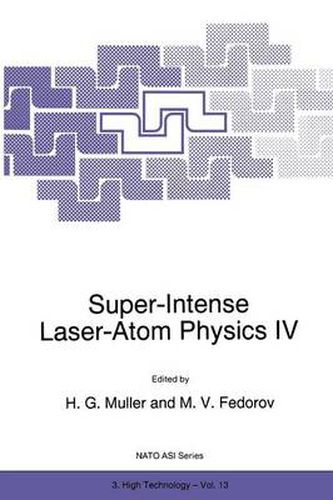Readings Newsletter
Become a Readings Member to make your shopping experience even easier.
Sign in or sign up for free!
You’re not far away from qualifying for FREE standard shipping within Australia
You’ve qualified for FREE standard shipping within Australia
The cart is loading…






This title is printed to order. This book may have been self-published. If so, we cannot guarantee the quality of the content. In the main most books will have gone through the editing process however some may not. We therefore suggest that you be aware of this before ordering this book. If in doubt check either the author or publisher’s details as we are unable to accept any returns unless they are faulty. Please contact us if you have any questions.
Atoms in strong radiation fields are interesting objects for study, and the research field that concerns itself with this study is a comparatively young one. For a long period after the ~scovery of the photoelectric effect. it was not possible to generate electro magnetic fields that did more than perturb the atom only slightly, and (first-or~er) perturbation theory could perfectly explain what was going on at those low intensities. The development of the pulsed laser bas changed this state of affairs in a rather dramatic way, and fields can be applied that really have a large, or even dominant influence on atomic structure. In the latter case, w~ speak of super-intense fields. Since the interaction between atoms and electromagnetic waves is characterized by many parameters other than the light intensity, such as frequency, iQnization potential, orbit time, etc., it is actually quite difficult to define what is exactly meant by the term ‘super-intense’. Obviously the term does not have an absolute meaning, and intensity should always be viewed in relation to other properties of the system. An atom in a radiation field can thus best be described in terms of various ratios of the quantities involved. The nature of the system sometimes drastically changes if the value of one of these parameters exceeds a certain critical value, and the new regime could be called super-intense with respect to that parameter.
$9.00 standard shipping within Australia
FREE standard shipping within Australia for orders over $100.00
Express & International shipping calculated at checkout
Stock availability can be subject to change without notice. We recommend calling the shop or contacting our online team to check availability of low stock items. Please see our Shopping Online page for more details.
This title is printed to order. This book may have been self-published. If so, we cannot guarantee the quality of the content. In the main most books will have gone through the editing process however some may not. We therefore suggest that you be aware of this before ordering this book. If in doubt check either the author or publisher’s details as we are unable to accept any returns unless they are faulty. Please contact us if you have any questions.
Atoms in strong radiation fields are interesting objects for study, and the research field that concerns itself with this study is a comparatively young one. For a long period after the ~scovery of the photoelectric effect. it was not possible to generate electro magnetic fields that did more than perturb the atom only slightly, and (first-or~er) perturbation theory could perfectly explain what was going on at those low intensities. The development of the pulsed laser bas changed this state of affairs in a rather dramatic way, and fields can be applied that really have a large, or even dominant influence on atomic structure. In the latter case, w~ speak of super-intense fields. Since the interaction between atoms and electromagnetic waves is characterized by many parameters other than the light intensity, such as frequency, iQnization potential, orbit time, etc., it is actually quite difficult to define what is exactly meant by the term ‘super-intense’. Obviously the term does not have an absolute meaning, and intensity should always be viewed in relation to other properties of the system. An atom in a radiation field can thus best be described in terms of various ratios of the quantities involved. The nature of the system sometimes drastically changes if the value of one of these parameters exceeds a certain critical value, and the new regime could be called super-intense with respect to that parameter.